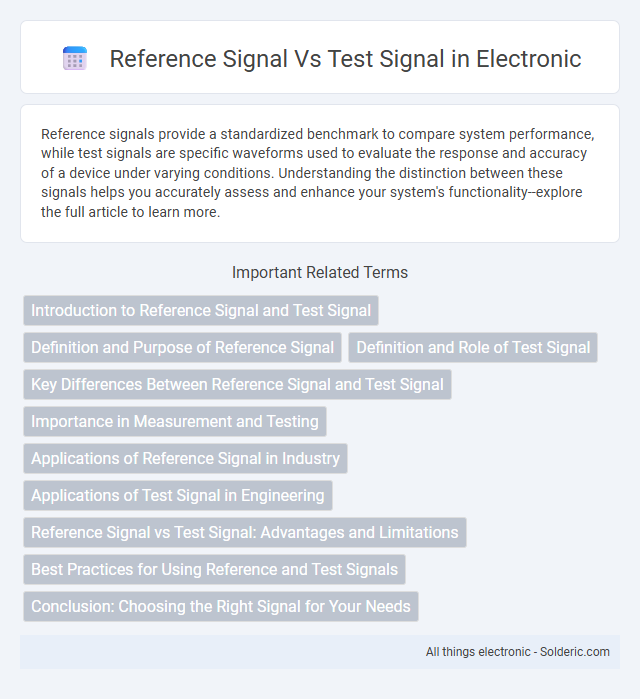Reference signals provide a standardized benchmark to compare system performance, while test signals are specific waveforms used to evaluate the response and accuracy of a device under varying conditions. Understanding the distinction between these signals helps you accurately assess and enhance your system's functionality--explore the full article to learn more.
Comparison Table
| Feature | Reference Signal | Test Signal |
|---|---|---|
| Purpose | Baseline for comparison | Signal under evaluation |
| Origin | Known and controlled source | Variable source or unknown conditions |
| Frequency | Stable and consistent | May vary or drift |
| Amplitude | Fixed or calibrated | Measured or variable |
| Phase | Defined and constant | May shift or fluctuate |
| Use in Testing | Benchmark for system performance | Evaluates system response or behavior |
| Noise Level | Minimal or zero noise | May contain noise/interference |
Introduction to Reference Signal and Test Signal
Reference signals serve as standardized inputs in measurement and calibration processes, enabling accurate system comparisons by providing a known baseline. Test signals, by contrast, are used to evaluate system responses under specific conditions, highlighting performance characteristics or identifying faults. Precise utilization of both signals is essential for ensuring reliable data acquisition and system validation across engineering and scientific applications.
Definition and Purpose of Reference Signal
A reference signal is a predefined, stable waveform used as a baseline to calibrate or synchronize measurement instruments, ensuring accuracy in signal processing tasks. It provides a known standard against which test signals are compared to detect deviations or distortions. The primary purpose of a reference signal is to enable precise evaluation, alignment, and quality control in communication systems, radar, and audio testing applications.
Definition and Role of Test Signal
A test signal is a predefined waveform or pulse used to evaluate the performance and behavior of electronic systems by stimulating specific components or circuits under controlled conditions. It enables accurate measurement of system response, identifying distortions, noise levels, or faults in signal processing paths. Unlike reference signals, which serve as stable comparison standards, test signals actively probe system characteristics to ensure proper function and calibration.
Key Differences Between Reference Signal and Test Signal
A reference signal serves as a stable and known benchmark for comparison, ensuring accuracy in measurement systems, while a test signal is the variable input applied to evaluate system performance or response. Reference signals often possess fixed characteristics like frequency and amplitude, whereas test signals vary depending on the parameter being tested. Understanding these key differences helps you accurately interpret test results and calibrate instruments.
Importance in Measurement and Testing
Reference signals provide a stable baseline crucial for accurate comparison during measurement and testing, ensuring the reliability of results by minimizing errors caused by fluctuations. Test signals are essential for stimulating the system under evaluation, allowing you to assess performance, detect faults, and verify functionality under controlled conditions. The interplay between reference and test signals enhances the precision of measurements and the validity of testing outcomes in various engineering and scientific applications.
Applications of Reference Signal in Industry
Reference signals play a critical role in industrial applications such as control systems, telecommunications, and instrumentation calibration, ensuring accurate system performance and stability. These signals serve as benchmarks for comparing test signals, enabling precise error detection and system adjustments in feedback loops. In wireless communication, reference signals facilitate channel estimation and synchronization, directly impacting data integrity and network efficiency.
Applications of Test Signal in Engineering
Test signals are essential in engineering for system identification, calibration, and performance evaluation of various devices and communication systems. They enable engineers to analyze system responses, detect faults, and optimize signal processing algorithms by providing controlled and repeatable inputs. Applications span across fields such as telecommunications, control systems, audio processing, and radar technology, where precise modulation and measurement of test signals ensure reliability and accuracy.
Reference Signal vs Test Signal: Advantages and Limitations
Reference signals offer a stable baseline for calibrating and comparing test signals, ensuring accuracy in measurement and system validation. Test signals, designed to simulate real-world conditions, help identify performance issues and system responses under dynamic environments. While reference signals provide consistency and repeatability, test signals reveal practical limitations and adaptive behavior, balancing theoretical precision with real-time application insights.
Best Practices for Using Reference and Test Signals
Best practices for using reference and test signals involve ensuring that the reference signal is stable, well-characterized, and free from distortion to provide a reliable baseline for comparison. Test signals should be generated with consistent amplitude and frequency parameters that match the conditions under which the signal will be analyzed to achieve accurate measurement and validation. Proper calibration of equipment and maintaining signal integrity throughout the testing process enhance the precision and reliability of results when comparing test signals against reference signals.
Conclusion: Choosing the Right Signal for Your Needs
Selecting the appropriate signal depends on the application requirements: reference signals provide consistent, predefined patterns crucial for calibration and performance evaluation, while test signals offer variable or real-world inputs for dynamic system analysis. Reference signals ensure reliability and repeatability in controlled environments, making them ideal for benchmarking and system tuning. Test signals are essential for stress testing and validating system behavior under practical conditions, enabling more comprehensive diagnostics and optimization.
reference signal vs test signal Infographic

 solderic.com
solderic.com